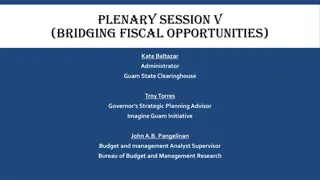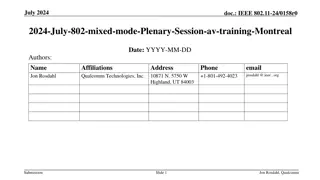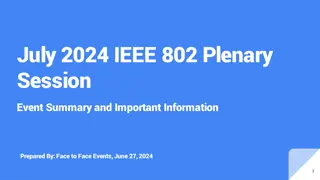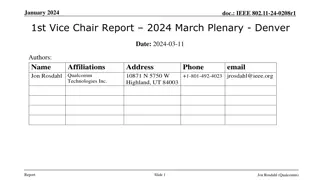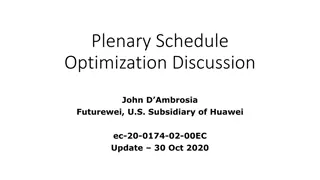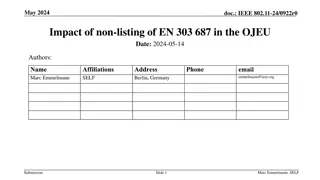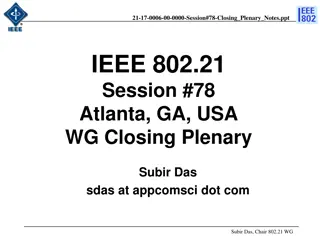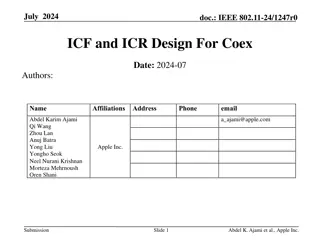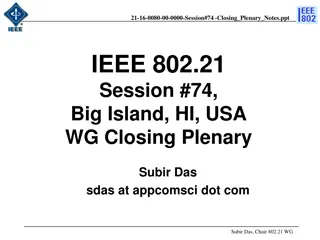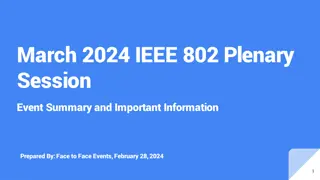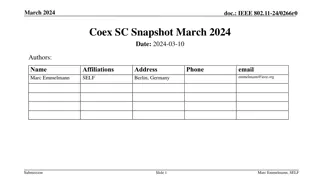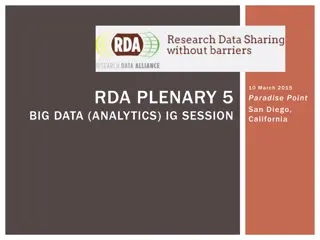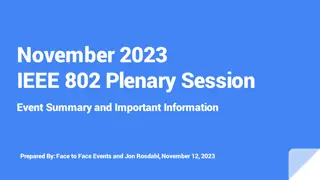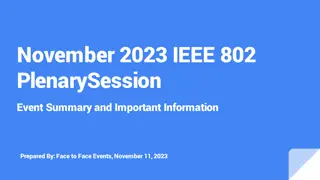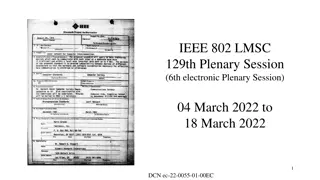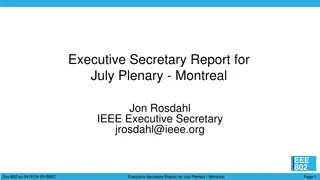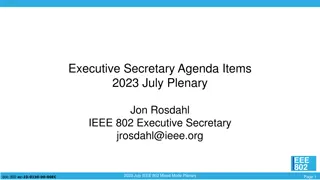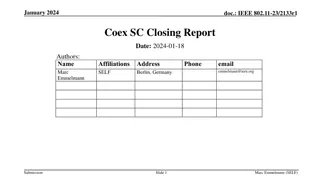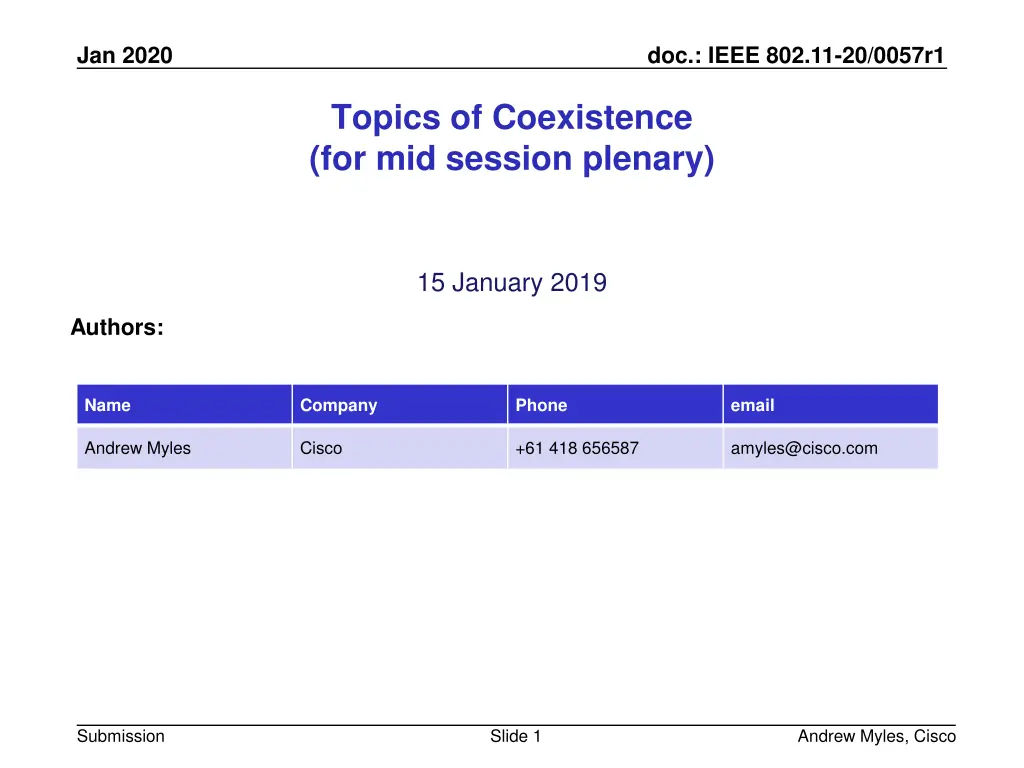
Wi-Fi Coexistence Challenges & Solutions
Explore the evolution of Wi-Fi from 1999 to 2020, detailing the impact on global communication and the challenges faced due to spectrum sharing with other systems, particularly in the 5 GHz and 6 GHz bands. Discover the transition from ED-only to PD/ED mechanisms and the importance of collaboration between IEEE 802.11 WG and ETSI BRAN for a harmonized approach. Gain insights into the debate around fair spectrum sharing and the initiatives taken to ensure efficient coexistence between Wi-Fi and other wireless technologies.
Download Presentation

Please find below an Image/Link to download the presentation.
The content on the website is provided AS IS for your information and personal use only. It may not be sold, licensed, or shared on other websites without obtaining consent from the author. If you encounter any issues during the download, it is possible that the publisher has removed the file from their server.
You are allowed to download the files provided on this website for personal or commercial use, subject to the condition that they are used lawfully. All files are the property of their respective owners.
The content on the website is provided AS IS for your information and personal use only. It may not be sold, licensed, or shared on other websites without obtaining consent from the author.
E N D
Presentation Transcript
Jan 2020 doc.: IEEE 802.11-20/0057r1 Topics of Coexistence (for mid session plenary) 15 January 2019 Authors: Name Company Phone email Andrew Myles Cisco +61 418 656587 amyles@cisco.com Submission Slide 1 Andrew Myles, Cisco
Jan 2020 Assistance is required to complete the 5 GHz rules & progress the 6 GHz rules in ETSI BRAN doc.: IEEE 802.11-20/0057r1 In the beginning from 1999 ... all was good for Wi-Fi, and Wi-Fi was good for all! Global impact Wi-Fi s success was put at risk by the need to share with other systems Starting in about 2014 Calls to action #1: Assist testing of the new proposed PD test signal with legacy devices in 5 GHz it appears a reasonable compromise is in place for sharing in 5 GHz band Now we are in 2020 #2: Help establish an IEEE 802.11 WG position for 6 GHz to liaise to ETSI BRAN the same debates about ED-only vs PD/ED are arising in context of 6 GHz Going forward Submission Slide 2 Andrew Myles, Cisco
Jan 2020 In the beginning from 1999 all was good for Wi-Fi, and Wi-Fi was good for all! doc.: IEEE 802.11-20/0057r1 Starting in about 1999 Wi-Fi became the primary user of unlicensed spectrum (2.4/5 GHz) and over time became the basis of a communications revolution with a phenomenal global socio-economic impact A WFA commissioned report in 2018 asserted an annual global economic value of Wi-Fi of $1.96T pa growing to $3.47T pa by 2023 Part of Wi-Fi s success was based on Wi-Fi systems sharing the spectrum reasonably well with other Wi-Fi systems thus enabling the use of Wi-Fi by anyone/anyplace/anytime Based on the efforts of the IEEE 802.11 WG in defining EDCA and the efforts of the WFA in certifying Wi-Fi implementations It also helped that Wi-Fi systems shared well with non-Wi-Fi systems Although that was mainly a result of systems like Bluetooth & Zigbee doing a good job avoiding Wi-Fi Submission Slide 3 Andrew Myles, Cisco
Jan 2020 Starting in about 2014 Wi-Fi s success was put at risk by the need to share with other systems doc.: IEEE 802.11-20/0057r1 Starting in about 2014 The cellular industry noticed the success of Wi-Fi, using lots of free, unlicensed spectrum, and decided to leverage it too The first attempt, LTE-U, was controversial because it decided what was fair rather than relying on a distributed technique like EDCA Eventually, it was accepted by most stakeholders that an EDCA-likeLBT mechanism was the best way of sharing between systems This conclusion was at least partially forced on 3GPP s LAA & then NR-U based on debates in ETSI BRAN about the adaptivity clause in EN 301 893 However, the L part of LBT remained controversial with: 3GPP advocating for an ED-only listen mechanism (as used by LAA/NR-U) 802.11 WG advocating for an PD/ED listen mechanism (as used by Wi-Fi) Indeed, a LS from 3GPP asking 802.11 WG to adopt an EDT of -72 dBm led to the formation of the PDED ad hoc and then the Coexistence SC Submission Slide 4 Andrew Myles, Cisco
Jan 2020 Now we are in 2020 it appears a reasonable compromise is in place for sharing in 5 GHz band doc.: IEEE 802.11-20/0057r1 Today, in 2020 A compromise has been established for Wi-Fi & LAA/NR-U sharing in the 5 GHz band based on an EDCA like sharing mechanism, using either a: PD/ED mechanism, with traditional Wi-Fi -82/-62 dBm thresholds ED-only mechanism, with a -72 dBm threshold This compromise has been documented in the latest draft of ETSI BRAN s Harmonised Standard for 5 GHz (EN 301 893) It was agreed partially because of the reality of legacy Wi-Fi in 5 GHz EN 301 893 is now heading towards approval, but its development has not been all plain sailing, with complications arising out of discoveries: Most Wi-Fi implementations send Beacons at PIFS, contrary to 802.11 Many Wi-Fi implementations require more than the 20 s 802.11a preamble for PD to operate as expected (see call to action on the next slide) It is believed/hoped this compromise will result in reasonably fair sharing The answer will need to wait for more LAA/NR-U deployments to appear Slide 5 Submission Andrew Myles, Cisco
Jan 2020 Call to action #1: please assist testing of the new proposed PD test signal with legacy devices in 5 GHz! doc.: IEEE 802.11-20/0057r1 Most Wi-Fi stakeholders believed that the reception of a correct 20 s 802.11a preamble @ > -82 dBm was sufficient to cause PD to operate This is what we told regulators, ETSI BRAN & 3GPP! It turns out after testing that many/most Wi-Fi devices require something more to validate the preamble It is now believed that two additional BPSK symbols will always work There is controversy on the need for energy in data part but that is a detail This surprise has damaged the Wi-Fi community s credibility, and complicates the specification & testing defined in EN 301 893 A new test signal has now been agreed in ETSI BRAN that contains two additional BPSK symbols (along with some variations related to energy) However, we need Wi-F vendors to test it with a variety of legacy devices to ensure we don t get it wrong a 2nd time there will not be a 3rd chance! Details will be discussed in the Coex SC meeting Submission Slide 6 Andrew Myles, Cisco
Jan 2020 Going forward the same debates about ED-only vs PD/ED are arising in context of 6 GHz doc.: IEEE 802.11-20/0057r1 The future, when 6 GHz is opened up The great thing about history is that is always repeats! Some cellular stakeholders (particularly Ericsson & Nokia) are strongly advocating again for ETSI BRAN s Harmonised Standard for 6 GHz (EN 303 687) to constrain the ED threshold to -72 dBm While Wi-Fi could still use the traditional PD/ED mechanism, it would need to use an EDT of -72 dBm There are some reasonable arguments both for & against this perspective and a whole bunch of unreasonable arguments Regardless, it is likely that ETSI BRAN will be making a decision in the next six months and it is vital that 802.11 WG has a position so that it can influence the outcome While EN 303 687 is Europe only, it will have global impact Submission Slide 7 Andrew Myles, Cisco
Jan 2020 The debate in ETSI BRAN about constraining EDT to -72 dBm is controversial with many conflicting arguments doc.: IEEE 802.11-20/0057r1 Constrain EDT to -72 dBm! Don t constrain EDT to -72 dBm! Evidence shows ED-only with lower EDT is better If lower EDT is better then Wi-Fi will use it naturally; if not then there is no need for a constraint! There is no legacy Wi-Fi in 6 GHz requiring use of PD/ED Evidence shows that PD/ED works better than ED-only; other systems can & should adopt the PD/ED mechanism Homogenous use of one mechanism is more likely to result in fair coexistence; ED-only should be chosen because it is more technology neutral Evidence shows ED-only works best with thresholds < -82 dBm, but low thresholds can only be implemented using PD The increased use of OFDMA in 6 GHz means less contention, and previous ED-only vs PD/ED sims are less relevant 802.11ax/be is defined to use PD/ED already and more and more Slide 8 Submission Andrew Myles, Cisco
Jan 2020 Call to action #2: help establish an IEEE 802.11 WG position for the 6 GHz to liaise to ETSI BRAN doc.: IEEE 802.11-20/0057r1 5 GHz (EN 301 893)!!! Compromise where any technology can use: ED-only @ -72 dBm PD/ED @ -82/-62 dBm 6 GHz (EN 303 678)??? Assumption based on 802.11ax (and preliminary 802.11be discussions) is that 802.11 WG wants to maintain the status quo from 5 GHz in 6 GHz However, the 802.11 WG has a responsibility to be evidence driven EN 301 893 enables in 5 GHz: 802.11ax/be to use PD/ED as it has always done, or ED-only LAA/NR-U to use its preferred ED-only So far the evidence suggests no change is justified What is the IEEE 802.11 WG position on 6 GHz rules? It is important that IEEE 802.11 WG has a say about the rules in EN 303 687 they will have an impact well beyond Europe and now is the time to say it! Please participate in the Coex SC this week to help develop & confirm a position for possible liaising to ETSI BRAN s next meeting in March 2020 Submission Slide 9 Andrew Myles, Cisco
Jan 2020 The Coex SC is meeting twice this week, on Wed PM1 & Thu PM1 please participate! doc.: IEEE 802.11-20/0057r1 Mon Tue Wed Thu Fri AM1 Closing AM2 COEX SC (motions) PM1 COEX SC PM2 Social EV1 Submission Slide 10 Andrew Myles, Cisco


